Copper foil shortage, CCL shortage, PCB delivery difficulties... Copper bullion and CCL price increase for more than half a year continue to affect the entire PCB industry. Less than a month after entering 2017, PCB boards have experienced a round of price increases. It is understood that PCB boards have risen 5% again in this round of price hikes. Compared with the previous price difference, the difference in PCB price is mainly for products with a thickness above 1.2 and a higher level.
For many small and medium-sized PCB factories, because there is no extra money to prepare the goods in advance, at the end of last year, some customers came to talk about price cuts, but the upstream material traders shouted again, and the rice was too expensive to cook, 1-2 Month is the peak period of downstream PCB shipments, and the number of restricted working days is reduced. It may be difficult for the printed circuit board factory to deliver on time after the year. In fact, in recent years, the prices of sheet metal and raw materials have been declining, and the demand has increased year by year, which has led many PCB companies to be squeezed out of the market because of price wars.
"Large companies have large purchases of raw materials and have certain bargaining chips. But small companies have no talks, and we say how much will rise if we rise. Otherwise, we will not supply them again. As a result, the cost of downstream small businesses will increase. The difficulty of survival will accelerate the merger, integration, and reshuffle.†A PCB raw material manufacturer said that CCL CCL and raw materials continue to rise, and there is a priceless market. Some small and medium-sized enterprises are more affected. In 2017, it will face the risk of capital chain breakage.
From the beginning of 2016 to the present, PCB standard copper foil prices have risen by more than 50%, and copper foil processing fees and effective CCL prices are 100% and 50% higher than the original average. At the beginning of November 2016, the price of raw copper soared to 48,000 yuan/ton. As the price of raw copper rose by 26%, the driving force for the price increase of electrolytic copper foil was transferred from processing fee to original copper price. The overall price of electrolytic copper foil has exceeded 110,000 yuan/ton. The mark. According to Taiwan media reports, in January 2017, there was another small-scale price increase in copper foil processing fees.
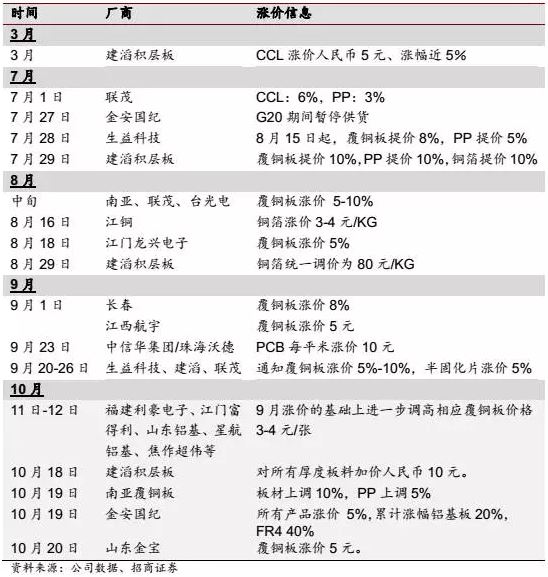
There are industry company CEOs frankly, "the production of copper-clad board, change the habit of paying in the past three or five months after the arrival of goods. With the purchase of copper foil with cash, the price of copper foil has increased by 20 to 30%, have to wait in line Order limited supply.†Plate trading generally accounts for 90 days to half a year. After the demand for lithium battery copper foil appears, some manufacturers take cash to buy materials, which indirectly causes vicious competition for price increases, and develops in the PCB circuit board industry. It has never been a thing for many years.
Copper foil has been in short supply in the past year. In March last year, the market share was the highest. The most influential CCL giants first issued a price increase notice. Other plate makers followed suit, stimulating the upstream and downstream supply chains. follow up.
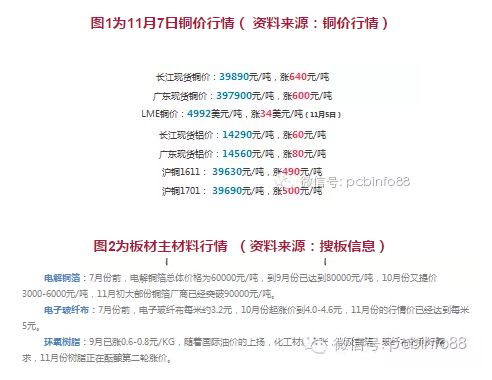
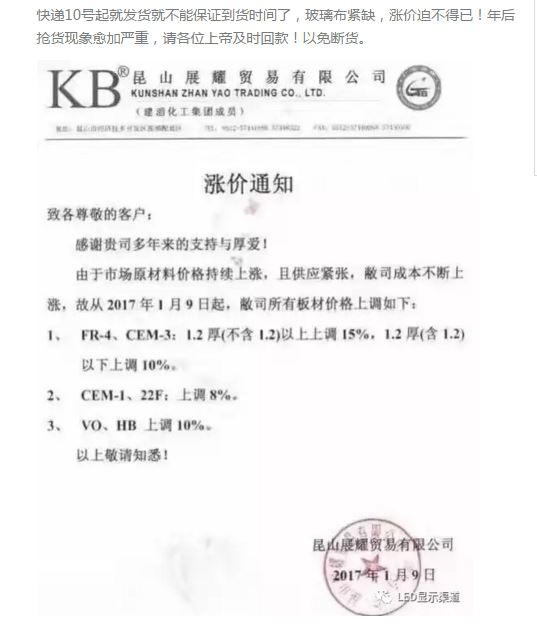
The shortage of copper foil supply also led to the rapid rise of other raw materials. It was reported in the industry that another glass fiber thick cloth of CCL may rise to 7 yuan/meter, and the cumulative increase of aluminum substrate and light guide plate is more than 20%. FR- 4 cumulative increase of more than 40%, plastic plates, plastic parts rose more than 10%, and even cash boxes for loading goods.
Copper foil, CCL manufacturers make big profits, PCB board factory is called bitter
In the past few years, copper foil processing prices have competed for price reductions, resulting in frequent losses at the break-even point or below, causing some domestic and foreign companies producing copper foil to go bankrupt, shut down or switch production, leading to the concentration of copper foil industry. Degree is further improved.
Now affected by price hikes and out-of-stocks, Taiwan’s copper foil factory Jinju Development has rid itself of the continuous loss of five years of dilemma. The revenue has hit a new high for more than six years. The stock price has turned several times. The domestic construction of the laminate has been net in 2016. The profit will reach 3.8 billion Hong Kong dollars, compared with the previous year's 1.3 billion Hong Kong dollars, the growth will exceed 200%; domestic medium-thick copper-clad board giant Jinan Guoji annual performance forecast shows that the net profit is 325-352 million yuan, year-on-year. Increase by 500%-550%.
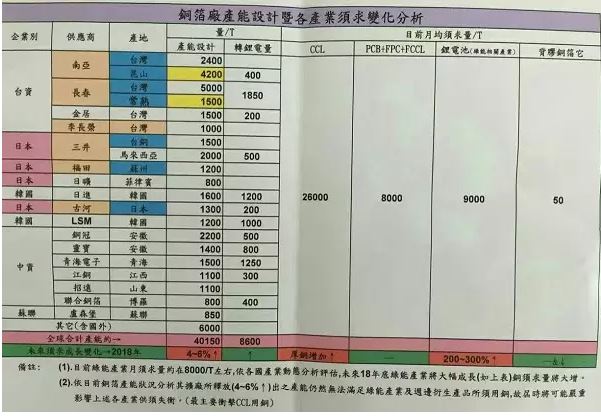
Manufacturers of printed circuit boards are generally showing red light. Not long ago, a domestic circuit board factory was deeply mired in financial difficulties. Previously, this circuit board factory ordered the purchase of materials as usual. As the processing fee per ton of electrolytic copper soared from 18,000 yuan to 36,000 yuan, it was notified by the materials manufacturer that the previous payment of more than 20 million yuan should be paid in advance to continue to purchase materials. The board factory borrowed the loan shark and paid the payment for the payment, and then received a notice to enter the advance payment to place an order. After some tossing, I finally entered the order of placing orders, but found that I had to wait in line for quotas. At this time, the company's capital chain was on the verge of breaking.
Due to the relatively strong downstream customers of PCBs, except for a small number of board factories that have carried out small price increases, most of the board companies have not successfully passed the rising costs to downstream customers, because PCB downstream customers generally have a large inventory of materials. In order to alleviate the financial pressure, some board manufacturers began to extend the payment period for PCB equipment manufacturers, PCB processing plants (such as PCB plating processing plants, PCB spray tin processing plants, etc.).
As a result, PCB equipment manufacturers, PCB processing plants suffered, and the days are also difficult to get up. Some small PCB processing plants are under pressure and are shut down.
Although the price of copper foil is getting higher and higher, but the copper foil factories are still in the market, many plate manufacturers and board manufacturers are holding cash to the copper foil factory to queue up for goods, and they may not be able to return the goods. The factory looked at the plate and sighed.
According to industry sources, many PCB companies that have a good relationship with CCL have stocked two to three months of plates, and some have a capacity of only 20,000 to 30,000. The inventory is about 100,000.
Difficult to expand production, copper foil, CCL price increase, when the stock is out of stock?
Copper foil, copper clad laminates and PCB manufacturers have been struggling for a long time. No one has thought that the lithium battery for vehicles will be born. This round of rising raw materials is so fast and lasting. This price increase is more the conversion of electronic copper foil capacity. Lithium-ion copper foil is triggered.
According to the latest statistics released by the Japan Electronic Circuit Industry Association, the output of printed circuit boards (PCB; hard board + flexible board + module substrate) in Japan fell to 1.293 million square meters in the same month of last year, and the production capacity ranked 11th. The monthly decline showed that the electronic soft board was reduced by nearly 30%. For example, a Japanese copper foil company with a monthly output of more than 3,000 tons has basically not used electronic copper foil used in China.
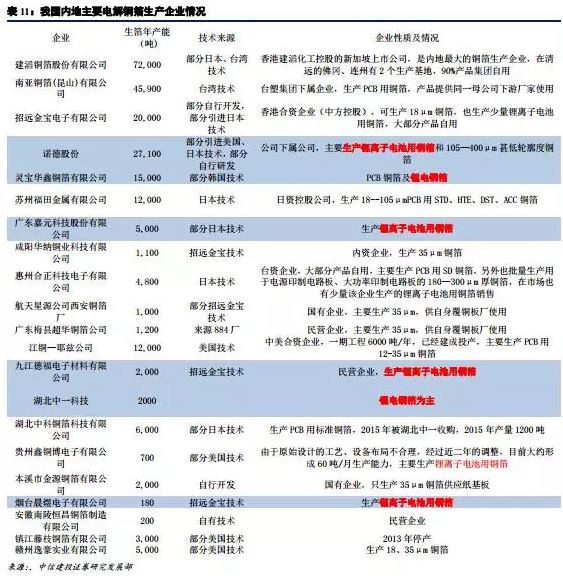
The global electronic copper foil production capacity is 41,000 tons per month, of which more than 8,000 tons have been discontinued. Japanese companies have already withdrawn from the electronic copper foil factory three years ago, and have switched to copper foil for high-speed boards, copper foil for high-frequency use, copper foil for packaging, and copper foil for flexible boards. In the entire supply chain, about 12,000 tons of electronic copper foil is gone. At present, whether it is a new copper foil enterprise or an old copper foil enterprise, all the expansions they have carried out are all around the expansion of lithium batteries.
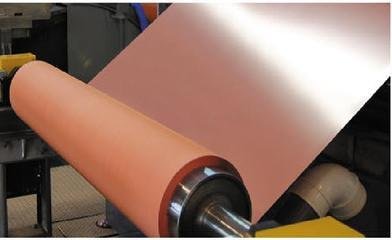
Since the new capacity production cycle of electrolytic copper foil takes 2-3 years, the shortage of copper foil for CCL and PCB will be the norm in the next 1-2 years. This is mainly because the core equipment for producing electrolytic copper foil is titanium cathode roller, which is monopolized by Japanese enterprises. The production cycle takes 3 months, and the delivery period is more than 1 year. At present, most of the orders for titanium cathode rollers are supplied to lithium-ion copper foil manufacturers. Unable to meet the expansion of CCL and PCB copper foil. In addition, lithium battery copper foil and CCL, PCB copper foil production characteristics and product requirements are different, CCL, PCB copper foil to lithium battery copper foil is easy, and vice versa is difficult to achieve.
In fact, as the other main material of CCL - electronic grade fiberglass cloth, it has been in an unprofitable or lossy state for many years, causing some electronic grade fiberglass cloth factories to stop production or reduce production. Recently, it has been learned that many domestic and foreign companies producing electronic grade glass fiber cloth are in the process of shutting down the production, and the maintenance period of a kiln is about half a year, which indicates that the supply of electronic grade fiberglass cloth will also drop sharply in the near future. The ensuing must be the price increase of electronic grade fiberglass cloth.
According to market news, starting from the first quarter of 2017, the PCB industry has shown a low season performance from upstream equipment plants, raw material plants to downstream manufacturing plants. First, the proportion of car boards for automotive electronics has increased from 0.5 square meters of copper foil substrates to 2 square meters. Second, it is said that the new iPhone 8 in the second half of the year will use a line width and a smaller line spacing. "SubstrateLike-PCB (SLP) technology, which will replace the previous HDI PCB technology.
If the CCL and PCB companies generally increase the inventory level and other factors, the supply of copper foil will be more tense.
It is reported that the equipment for the production of copper foil for the supply of lithium-ion copper foil for new energy vehicles has been scheduled for the second half of 2017. It is estimated that the shortage of copper foil, CCL, PCB manufacturers need to suffer at least one and a half to two years. Two or three years later, it is likely that some copper foil manufacturers will return to CCL and PCB again due to fierce competition in lithium batteries for new energy vehicles.
Raw materials continue to rise, how does the PCB industry break through?
The price of electronic copper foil remained at a high level, and the increase should not be large. At present, most PCB board factories have started construction after the year. Although the supply of raw materials is more tight, the production of new energy vehicles has entered the off-season. Some copper foil factories have turned their production capacity back to the PCB market. Some PCB factories have prepared in advance, the actual supply. Not so nervous.
In fact, the price of sheet metal only accounts for about 1/3 of the total price of PCB. The proportion of the price of copper foil on the price of sheet metal is far greater than the price of PCB. The PCB market is in a long-term vicious competition. The product increase of the leading manufacturers is not high. It is the first price increase for small and medium-sized enterprises.
Most small and medium-sized PCB board factories do not have enough cash hoarding sheets. The procurement cycle is extremely short, the sheet price rises, and the cash demand increases, resulting in a tight capital chain. Because of the small output, its profit is also the largest affected by the price of the plate. These two points make the small and medium-sized PCB board factory suffer from the price increase of the board, so the price increase demand is first issued, resulting in the loss of orders.
The price increase of raw materials will eliminate some manufacturers, but it will help the large capital-rich enterprises to obtain more customers and further concentrate on the industry to regulate the market. Because when there is demand for board procurement, they have stronger bargaining power and the right to pay for the upstream suppliers compared with similar manufacturers, which further controls the cost and keeps the supply of materials smooth.
On the one hand, when the boardmakers negotiated with customers in 2017, they knew that the market is now so likely that they would not ask for a big price cut. Circuit board manufacturers may be able to change the mode of collection before delivery, and transfer to delivery. The shortage of plates is inevitable, and the board factory must have long-term plans.
On the other hand, this madness is unsustainable, the copper foil market continues to be hot, and there is a hype. Lithium-ion copper foil will not continue to grow every month, nor will it expand at a high speed. Board factories should be rational, should not blindly follow the trend, bidding for goods and then price wars, carefully consider the variety and quantity of incoming goods, do not chaotic purchase.
With the strong demand for new energy vehicles, mobile phones, small LED spacing, communication base stations and other electronic market segments, the PCB industry is gradually picking up. Circuit board manufacturers should seize this opportunity to continuously improve their quality, strive for excellence and improve yield. To reduce costs and avoid vicious competition, we can break through the encirclement.
For the copper foil industry, it is necessary to make full use of this price increase opportunity to improve product technology and quality, and promote the technological progress of copper foil. Now entering the era of high-frequency and high-speed materials, domestic manufacturers can't do it, and Taiwanese manufacturers can't do it.
It is designated by the Japanese manufacturer. Because the copper foil factory is not profitable, there is no technical investment, no technological progress, this enterprise will not last long. Such an industrial chain is also unhealthy, and it is not good for ourselves. Now these copper foil factories are taking advantage of this good opportunity to increase R&D investment is undoubtedly beneficial to the industry.
In the long run, rising raw material prices will accelerate the elimination of uncompetitive small and medium-sized enterprises, so that the market will be further concentrated, which will prompt the industry to return to rationality and contribute to the healthy development of the industrial chain.

EDP is gradually replacing the existing low voltage differential signal (LVDS) transmission interface, especially in FHD(1,920x1,080 or 1,920x1,200) or panel (UHD) that exceeds FHD resolution.
EDP can dynamically control the refresh frequency of the display panel, which is designed to reduce power consumption when displaying a still picture. In still images, the panel refresh rate can be reduced from a normal 60 images per second to any frequency that does not produce abnormal or flickering images. Reducing the refresh rate reduces power consumption and extends battery life, with some panels down to 40fps or less.
Another application that USES different display refresh rates is when playing movies or games. In game mode, the screen is often calculated by the graphics computing engine before being displayed, and there will be a delay time in the middle. In this case, the refresh frequency of the panel can be dynamically adjusted to make the screen display smooth, without distortion and delay. When playing the movie, the 24FPS picture can be adjusted to 48FPS, so as to eliminate the situation that the picture is not smooth due to the 3:2 pull-down in the traditional 60FPS mode.
Through AUX channel, eDP can control the following functions of the display panel:
Turn on or off the backlight
Backlight brightness adjustment and backlight PWM frequency are adopted.
Turn on or off dynamic backlight adjustment.
Color engine, jitter algorithm or insert black screen for adjustment.
Edp To Dp Cable,Aclu2 Edp Cable,Cg511 Edp Cable,Edp To Displayport Adapter
Tonya Display Limited , https://www.tydisplay.com